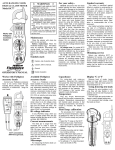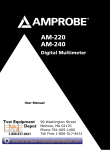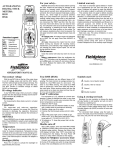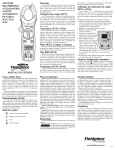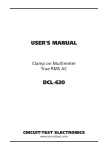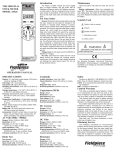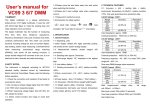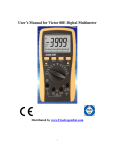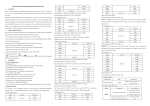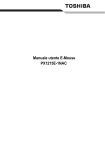Download User Manuals - Fieldpiece Instruments
Transcript
AUTO-RANGING DIGITAL CLAMP METERS: SC44, SC45, SC46 CLAMP CAT.III Description Temperature (SC45 and SC46) Non-contact voltage Field Temperature calibration (SC45 & SC46) The mini clamp-on meters are made for the technician who is looking for a small, low cost meter that has most of the functions he needs, day in and day out, without some of functions and convenience features available on bigger meters. 300V 400A With the grey tip on the amp clamp head close to an AC voltage, press and hold the NCV button. The NCV LED will light and the beeper will beep. The closer you get to AC voltage, the louder the beep. The NCV function is sensitive enough to detect 24VAC on thermostats. (24V to 600V, 50Hz to 60Hz) Capacitance (SC45 amd SC46) NCV For motor-start and motor-run capacitors. Disconnect the capacitor from power first. If the capacitor is connected to the meter and “dsc” symbol is shown on the LCD, it means there is voltage existing in the tested capacitor and needs to be discharged before testing. Short the terminals to discharge the capacitors. Disconnect any resistors that might be between the terminals of the capacitor. Hold Press HOLD once to keep the latest reading displayed on the meter in the memory. Press the HOLD button again to go back to normal mode. True RMS (SC46) Digital multimeters use two different types of AC sensing. The most common is average sensing, normalized to a true RMS value of a sine wave. The other is true RMS sensing. The actual true RMS value is sensed. Either sensing method will give the same results on a clean sine wave but they may differ on a non-sinusoidal waveform. OPERATOR’S MANUAL Using the best range Autoranging meters automatically select the range that gives you the best resolution. For example, when measuring 24VAC, the meter will select the 40VAC range and display "24.0". In the 400Vrange, you'd see "24" and in the 4V range you'd see "OL" for overload. When an n (nano), m (micro), m (milli), K, or M shows up in the display, you must multiply by 10-9, 10-6, 10-3, 103, and 106 respectively. You can manually select the range by pressing the O button until you get the range you want. This can keep the decimal from bouncing around when measuring a parameter that varies from just a little below the top of the range to a little over. Caution, refer to manual. General: Disconnect the test leads before opening the case. Inspect the test leads for damage to the insulation or exposed metal. Replace if suspect. Never ground yourself when taking electrical measurements. Do not touch exposed metal pipes, outlets, fixtures, etc., which might be at ground potential. Keep your body isolated from ground by using dry clothing, rubber shoes, rubber mats, or any approved insulating material. When disconnecting from a circuit, disconnect the "RED" lead first, then the common lead. Work with others. Use one hand for testing. Turn off power to the circuit under test before cutting, unsoldering, or breaking the circuit. Keep your fingers behind the finger guards on the probes. Do not measure resistance when circuit is powered. Do not apply more than rated voltage between input and ground. All voltage tests: All voltage ranges will withstand up to 600V. Do not apply more than 600VDC or 600VAC rms. AC tests: Disconnect the meter from the circuit before turning any inductor off, including motors, transformers, and solenoids. High voltage transients can damage the meter beyond repair. Do not use during electrical storms. Ground Maintenance Backlight (SC46) The SC46 has a backlight that allows the user to read the display in any lighting conditions. Make sure the area being tested is well lit. The backlight comes on when the button is depressed and stays on for 60sec before turning off to conserve battery life. Symbols used: Caution, risk of electric shock ! For your safety... Double insulation Clean the exterior with clean dry cloth. Do not use liquid. Battery replacement: When the multimeter displays " " the battery must be replaced. Disconnect and unplug leads, turn meter off, and remove the battery cover. Replace both of the two AAA (1.5V) batteries. Plug any K-type thermocouple directly into the meter to measure temperature. Temperature measurement will be accurate even in fast changing environments because of excellent temperature compensation. No thermocouple adapter is required. For accuracies of ±1°, calibrate to a known temperature. A glass of stabilized ice water is very close to 32°F (0°C) and is usually very convenient but any known temperature can be used. 1. Select 400°F/C range and connect thermocouple. 2. Remove back case (2 screws on back, one near clamp, other near base). Leave battery cover attached so batteries stay within back case. VR5 3. Stabilize a large cup of ice water. 4. Immerse the thermocouple tip and let it stabilize. Jumper 5. To change the temperature scale to °C, close the jumper just below VR5. 6. Adjust VR5 calibration pot with a small screwdriver to get within 0.1° of 32°F (0°C). Each 1/4 turn should adjust the temperature about 3°, no more than 10° total. There’s no need rotating the screw more than 360°; doing so gets you back to where you started. 7. Attach case without screws to preview the temperature and continue until you have it dialed in. Disable auto off Set to OFF position, press and hold (SC44 and SC45) or (SC46) button while turning rotary dial to desired range position. Release the button when LCD displays normally. Note: “APO” annunciator will be missing from the display. The Auto Power Off mode is on when “APO” indicated on the display. Limited warranty This meter is warranted against defects in material or workmanship for one years from date of purchase. Fieldpiece will replace or repair the defective unit, at its option, subject to verification of the defect. This warranty does not apply to defects resulting from abuse, neglect, accident, unauthorized repair, alteration, or unreasonable use of the instrument. Any implied warranties arising from the sale of a Fieldpiece product, including but not limited to implied warranties of merchantability and fitness for a particular purpose, are limited to the above. Fieldpiece shall not be liable for loss of use of the instrument or other incidental or consequential damages, expenses, or economic loss, or for any claim of such damage, expenses, or economic loss. State laws vary. The above limitations or exclusions may not apply to you. Obtaining service Call Fieldpiece Instruments for one-price-fix-all warranty service pricing. Send check or money order for the amount quoted. Send the meter freight prepaid to Fieldpiece Instruments. Send proof of date and location of purchase for in-warranty service. The meter will be repaired or replaced, at the option of Fieldpiece, and returned via least cost transportation. www.fieldpiece.com v14 Voltage Temperature Resistance 300V 400A CLAMP CAT.III Amps AC Through Clamp Disconnect test leads from voltage before plugging in thermocouple! Insure the temperature being measured is stable. Maintain good contact between the thermocouple and what's being measured. Capacitance NCV V NC 30 40 0V 0A CL CA AMP T.I II SPECIFICATIONS Display: 3¾ digit liquid crystal display (LCD) with a maximum reading of 3999. Range : Manual ranging mode (SC44 & SC45), hold button for 2 seconds to return to autoranging mode. Overrange: "OL" or “-OL” mark indication. Auto power off: 10 minutes. Operating environment: 32 to 122°F (0 to 50°C), at <70% R.H. Storage temperature: -4 to 140°F (-20 to 60°C), @ <80% R.H. with batteries removed. Accuracy: Specifications good in ambient conditions of 74°F ±8°F (23°C ±4°C), <75% relative humidity. Temperature coefficient: 0.1×(specified accuracy) per °F/°C; 32 to 66°F (0 to 19°C); 82 to 122°F(28 to 50°C). Altitude: 6561.7 feet (2000m). Power: Two AAA 1.5V batteries. Battery life: 400 hours typical with alkaline (SC44), 300 hours typical with alkaline (SC45), 200 hours typical with alkaline (SC46). Accessories: One pair test leads, (2) 1.5V AAA batteries (installed), carrying case and operating instructions. Safety: Designed to meet IEC61010-1 (EN61010-1) and IEC61010-2-032 (EN61010-2-032), CATIII 300V, class II and pollution degree 2 indoor use comply with CE, C-tick certified. Temperature (SC45 and SC46) Range: -30 to 400°F (-34 to 204°C) Resolution: 0.1° Accuracy: ±1°F (32 to 120°F); ±0.5°C (0 to 49°C), ±1% + 1.5°F (-4 to 400°F); ±1% + 1°C (-20 to 204°C), ±2% + 4°F (-30 to -4°F); ±2% + 2°C (-34 to -20°C) Sensor type: K-type thermocouple Capacitance (SC45 and SC46) Range: 4μF, 40μF, 400μF, 4mF 4.000mF = 4000μF Resolution: 1.0nF Accuracy: ±(3% rdg + 10 dgts) on 4μF ±(3% rdg + 5 dgts) on 40μF to 400μF ±(5% rdg + 20 dgts) on 4mF (4000μF) Minimum input range: >100nF Safety: “dsc” symbol on LCD indicates that the capacitor must be discharged before testing. Continuity Ranges: 400mV (except SC46), 4V, 40V, 400V, 600V Resolution: 0.1mV (1mV for SC46) Accuracy: ±(0.5% rdg + 2 dgt) Input impedance: 400mV > 100MΩ 4V = 10MΩ 40V~600V = 9.1MΩ Transient protection: 6kV for 10μ sec Diode Test VAC/DC 600VDC or AC RMS AC volts (50Hz - 500Hz) AAC 400AAC Resistance 500VDC or AC RMS Continuity 500VDC or AC RMS Diode 500VDC or AC RMS Capacitance (SC45 and SC46) 500VDC or AC RMS Temperature (SC45 and SC46) 60VDC or 30AC RMS DC volts True RMS: SC46 only, Crest factor: ≤3 Ranges: 4V, 40V, 400V, 600V Resolution: 1mV Accuracy(SC44, SC45): ±(1.2% rdg + 5 dgts), ±(1.5% rdg + 5 dgts) on 600V range Accuracy(SC46): ±(1.2% rdg + 8 dgts), ±(1.5% rdg + 8 dgts) on 600V range Input impedance: 4V = 10MΩ 40V~600V = 9.1MΩ Resistance Ranges: 400Ω, 4kΩ, 40kΩ, 400kΩ, 4MΩ, 40MΩ SC45 and SC46 only have a 400Ω range. Resolution: 0.1Ω (1Ω for SC45, SC46) Accuracy: ±(1.0% rdg + 4 dgts) on 400Ω to 400kΩ ranges ±(1.5% rdg + 4 dgts) on 4MΩ range ±(3.0% rdg + 5 dgts) on 40MΩ range Open circuit volts: -0.45VDC typical, (-1.2VDC on 400Ω range) AC Current (50Hz - 60Hz) True RMS: SC46 only, Crest factor: ≤3 Ranges: 40A, 400A, Resolution: 0.01A Accuracy(SC44, SC45): ±(2.0% rdg + 6 dgts) Accuracy(SC46): ±(2.0% rdg + 10 dgts) Audible indication: Less than 25Ω Response time: 500ms Test current: 1.2mA (approximate) Accuracy: ±(3.0% rdg + 3 dgts) Resolution: 10mV Audible indication: Less than 0.25V Open circuit volts: 3.0VDC typical Overload Protection (SC44, SC45, SC46) ! WARNINGS ! DISCONNECT AND UNPLUG TEST LEADS before opening case. TEST NCV FUNCTION ON KNOWN LIVE WIRE before using. DO NOT APPLY VOLTAGE greater than 30VAC or 60VDC to the thermocouple or the jacks when the rotary dial is on OFF. REMOVE THE THERMOCOUPLE when taking voltage measurements. DISCONNECT THE TEST LEADS when taking temperature measurements. DO NOT APPLY VOLTAGE TO THE JACKS when the rotary dial is on microamps. Even low voltages can cause a current overload and blow the fuse. Replace blown fuse to regain function.


